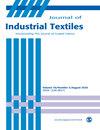Development of essential oil-containing antimicrobial and deodorizing nanofibrous membranes for sanitary napkin applications
IF 2
4区 工程技术
Q1 MATERIALS SCIENCE, TEXTILES
引用次数: 0
Abstract
In this study, antimicrobial and deodorizing nanofibrous composite membranes based on natural substances were developed for use in feminine sanitary napkins. Plant-derived natural essential oils, such as lemongrass oil and May Chang oil, were incorporated into polyvinyl alcohol nanofibers using emulsion electrospinning. The fiber morphology, oil distribution, and pore size distribution of the nanofibrous composite membranes were examined. The antimicrobial and deodorizing effects, tensile properties, and release behavior of the functional ingredients from the composite membranes were investigated to examine their use in sanitary napkins. Core–sheath nanofibers, in which lemongrass oil or May Chang oil was uniformly distributed within the fiber core, were fabricated using various oil contents. The essential oil-loaded nanofibrous composite membranes contained pores ranging from 0.130 to 1.349 µm in size. The release profiles of the essential oils from the composite membranes over an 8 h period demonstrated a continuous release of citral and limonene. Composite membranes containing either lemongrass oil or May Chang oil exhibited outstanding antimicrobial effects against vaginal pathogens, such as Candida albicans and Staphylococcus aureus, despite their low oil content. Deodorizing effects against ammonia gas were observed at oil contents higher than that required to achieve antimicrobial effects. The composite membranes exhibited lower Young’s modulus and greater elongation at break values under wet conditions compared to dry conditions. Our findings demonstrate that antimicrobial and deodorizing nanofibrous composite membranes based on plant-derived essential oils have the potential for use in feminine hygiene products.开发用于卫生巾的含精油抗菌除臭纳米纤维膜
本研究开发了基于天然物质的抗菌除臭纳米纤维复合膜,可用于女性卫生巾。利用乳液电纺丝技术将植物提取的天然精油(如柠檬草油和五月香油)融入聚乙烯醇纳米纤维中。研究了纳米纤维复合膜的纤维形态、油分布和孔径分布。研究了复合膜的抗菌和除臭效果、拉伸性能以及功能成分的释放行为,以探讨其在卫生巾中的应用。利用不同的油含量制造了芯-鞘纳米纤维,其中柠檬草油或五月嫦油均匀地分布在纤维芯中。负载精油的纳米纤维复合膜含有 0.130 至 1.349 微米大小的孔。复合膜在 8 小时内的精油释放曲线显示,柠檬醛和柠檬烯可持续释放。含有柠檬草油或五月香油的复合膜尽管油含量较低,但对白色念珠菌和金黄色葡萄球菌等阴道病原体具有突出的抗菌效果。当油脂含量高于达到抗菌效果所需的油脂含量时,就能观察到对氨气的除臭效果。与干燥条件相比,复合膜在潮湿条件下的杨氏模量更低,断裂伸长率更大。我们的研究结果表明,基于植物萃取精油的抗菌除臭纳米纤维复合膜具有用于女性卫生用品的潜力。
本文章由计算机程序翻译,如有差异,请以英文原文为准。
求助全文
约1分钟内获得全文
求助全文
来源期刊

Journal of Industrial Textiles
MATERIALS SCIENCE, TEXTILES-
CiteScore
5.30
自引率
18.80%
发文量
165
审稿时长
2.3 months
期刊介绍:
The Journal of Industrial Textiles is the only peer reviewed journal devoted exclusively to technology, processing, methodology, modelling and applications in technical textiles, nonwovens, coated and laminated fabrics, textile composites and nanofibers.
 求助内容:
求助内容: 应助结果提醒方式:
应助结果提醒方式:


